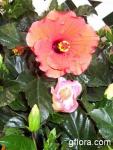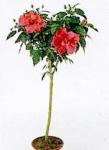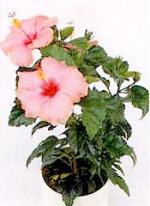|
|
HibiscusFamily: Malvaceae.
|
Common name(s): Chinese hibiscus, Rose of China |
|
 |
Genus of more than 200 species of deciduous and evergreen shrubs, trees, annuals, and herbaceous perennials, widely distributed in warm-temperate, subtropical, and tropical regions, in a variety of habitats. Hibiscus rosa-sinensis has so many varieties in so many colors and sizes! The large showy flowers come in shades of golden, pink, rose, yellow and orange, at times with colorful markings or double-petals. Some flowers grow to 1 ft. across. The state flower of Hawaii, the tropical Chinese Hibiscus is often grown in containers. All are heat-loving and flower during the warmest months of the year. Prune to control shape and fertilize monthly during the growing season. Protect from wind. Insects and diseases can cause problems. A Hibiscus bush can live for 20 years or more, and may be kept small by regular pruning - cut back stems in late winter to induce bushiness. It can also be trained as a standard. |
 |
| Growing conditions |
Watering and misting |
Propagation |
| Average or above average warmth in summer. Keep fairy cool in winter - minimum temperature 60 F or 18 C. Bright light - avoid direct sunshine. Grow in soil-based potting mix. |
Water freely from spring to autumn - sparingly in Winter. Use tepid water. Mist leaves frequently, especially in hot weather. |
Take stem cuttings in spring. Sow seed at 55-64 F (13-18 C) in spring. Layer in spring and summer. |
|
Hibiscus rosa-sinensis L. |
|
|
|
 |
|
These materials are freely provided for instructional and educational purposes. Any duplication or publication of text or images herein for commercial gain without explicit written permission of the owner or photographer constitutes breach of trust and violation of copyright.
Copyright © Galka Okhapkina 1998-2025



